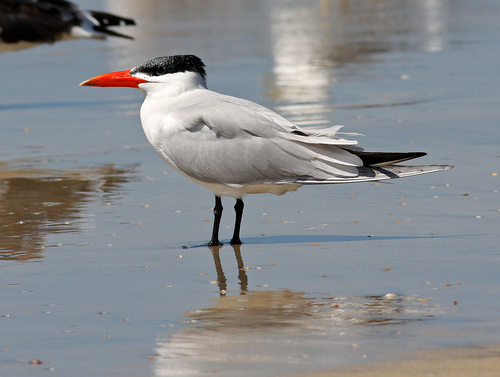
Caspian Tern
The Caspian Tern (*Hydroprogne caspia*) is the world's largest tern species, notable for its impressive size and robust build. It has a wide, almost global distribution, found on every continent except Antarctica. This powerful flier plays a significant role in coastal and inland wetland ecosystems, primarily as a fish predator. While not currently considered globally threatened, certain populations face localized pressures. The Caspian Tern holds little widespread cultural significance but is valued by birdwatchers for its striking appearance and commanding presence.
48-56 cm
Length
127-140 cm
Wingspan
Least Concern
Conservation Status
Distribution
Caspian Terns have a nearly worldwide distribution, breeding in North America, Europe, Asia, Africa, and Australasia. They are highly migratory, with many populations undertaking long-distance movements between breeding and wintering grounds. Their altitudinal range extends from sea level to inland lakes and rivers, sometimes at considerable elevations.
Lifespan
Typically 12-17 years in the wild, with records of individuals living over 25 years.
Caspian Tern's Habitat
Habitat Types
Coastal areas, Estuaries, Large inland lakes, Rivers, Reservoirs
Climate Zones
Tropical, Subtropical, Temperate, Boreal
Adaptations
Caspian Terns are well-adapted to a variety of aquatic environments. Their strong flight allows them to cover large distances when foraging or migrating. Their large bills are well-suited for catching fish, their primary prey.
Variations
While generally considered monotypic (no recognized subspecies), some regional variations in size and plumage have been observed, though they are not formally classified.
Appearance
Breeding Plumage
Breeding adults have a black cap, white body, and pale grey back and wings. Non-breeding adults have a streaked black and white crown.
Seasonal Feather Changes
The black cap becomes more extensive and solid during the breeding season, fading and becoming streaked in the non-breeding season.
Sex Based Plumage Differences
Males and females have similar plumage.
Notable Features
Large, thick, bright red bill., Black legs., Slightly forked tail., Powerful, direct flight.
Diet and Feeding
Primary Foods
Small to medium-sized fish, Occasionally crustaceans, Rarely insects and eggs/chicks of other birds
Foraging Behavior
Caspian Terns typically forage by flying over water and plunge-diving to catch fish. They may also hover briefly before diving. They often forage alone or in small groups.
Specializations
Their large bill and strong neck muscles are adaptations for catching and handling relatively large fish.
Seasonal Diet Variations
Diet may vary slightly depending on the availability of fish species in different locations and seasons. During migration, they may rely on different prey resources than during the breeding season.
Behavior
Social Structure
Caspian Terns are colonial breeders, often nesting in large groups with other terns and gulls. Outside of the breeding season, they may be found in smaller flocks or individually.
Communication
Loud, harsh 'kraa' calls., Various other vocalizations used during courtship and territorial defense.
Migration
Many populations are highly migratory, traveling long distances between breeding and wintering grounds. Migration routes are often along coastlines but can also cross over land.
Territorial or Group Behaviors
Caspian Terns are highly territorial during the breeding season, aggressively defending their nest site from intruders. They will mob potential predators, including humans.
Conservation
Threats
Habitat loss and degradation (coastal development, wetland drainage), Human disturbance at breeding colonies, Pollution (including pesticides and heavy metals), Changes in prey availability (due to overfishing or climate change), Predation by introduced species (on some islands)
Protection Programs
Monitoring of breeding colonies, Habitat restoration and protection, Legal protection under various national and international laws, Public awareness campaigns
Local National Laws
Protected under the Migratory Bird Treaty Act in the United States and Canada, and similar legislation in other countries.
Population Trend
Stable
Population Estimates
The global population is estimated to be around 500,000 individuals.
Interesting Facts
They are the largest tern species in the world.
Their size and robust build distinguish them from other terns.
They can be found on every continent except Antarctica.
This demonstrates their adaptability to a wide range of environments.
They are known for their aggressive defense of their nesting colonies.
They will dive-bomb intruders, including humans, to protect their eggs and chicks.
Their calls are distinctively harsh and loud.
It is often described as a raspy 'kraa-haa'.
Faqs about Caspian Tern
What do Caspian Terns eat?
They primarily eat fish, which they catch by plunge-diving into the water.
Where do Caspian Terns nest?
They nest in colonies on the ground, usually on bare sand, gravel, or shell beaches near water.
Are Caspian Terns endangered?
No, they are currently classified as Least Concern by the IUCN, but some populations face localized threats.
How can I identify a Caspian Tern?
Look for a large tern with a thick, bright red bill, a black cap (streaked in non-breeding plumage), and pale grey upperparts.
Copyright @ Nature Style Limited. All Rights Reserved.
 English
English